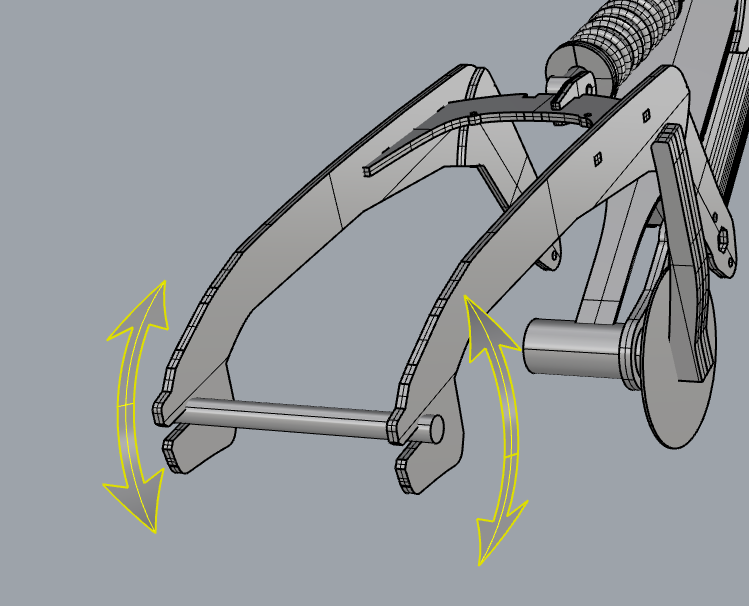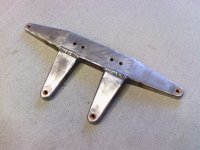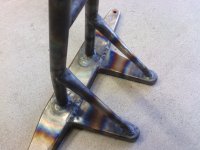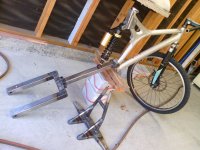Nice to see this coming along.
SafeDiscDancing said:
calab said:
At least you do something to progress a project in a timely manner.
Henry Ford was a fascist and was all about pushing, pushing, pushing production harder.
Henry Ford calculated how many steps/day a single worker at a single station could make without compromising employee efficiency ( getting the jobs done). He found that if a worker was placed greater than three steps away from the worker next to him, he would waste the time to walk to the next station.
....he found if he placed the workers within two steps of each other, the worker efficiency increased. So he made any two stations less than two steps away from the one next to it. ....
Yes.
For swingarm ( engineering load distribution wthin the beam) inspiration, look at the early CBR 600F swingarm. Not braced, steel, 1" x 2" box section, 90 horsepower. 140mm section rear wheel. This bike was a work of art and won every race for many years. The mooring is very strong with large bearing, and the swinger itself was not very.. strong. High strung, High RPM, tweaky 90hp engine with 43.3lbft @ 8,oooRPM, 12,000RPM red line... and a close ration transmission made for quite the zippyzippy motorcycle..... Some called it " The bike that started it all". 140mph plus top speed,.
Racing Motorcycles then moved, to a very braced, very stiff, large, light, cast aluminum, swingarm, for those power levels, and the F1 Hurricane is now a dinosaur.
Beam load is well enumerated. Steel box section loaded in certain direction is very strong. They did use it in racing motorcycles.
Here you can see how the side load of the spinning wheel destroyed the light swingarm when the motorcycle hit the telephone pole @ 90*. Ridiculously light for the power exhibited. This bike would flex from handling,.. around fast turn. Could still put the power down good, off the corner. Bent like a Banana.
For the most part, it was designed in, the flex. Made to do a job. I think you will be fine.

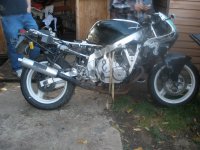
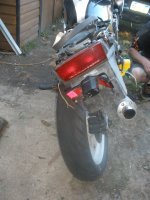
E-HP said:
owhite said:
My prediction is that when you turn, especially in a lean, the swingarm will twist and wag in directions that will impact bike performance.
I was under the impression, probably wrong, that the bike was being built for a specific purpose, which doesn't involve much turning, although the twisting could still be an issue.
99t4 said:
Should be OK. Failure there should not cause serious injury, as opposed to front wheel falling off, or steering locking, braking failure, etc.
SafeDiscDancing said:
Guys relax.

This is 1.5" Square Tubing.
It's overkill. Massive rigidity. I know how to build things.
I agree. The rear wheel is very light, you should be fine, with that section, steel box, with a good mooring and good bearing.
My swinger on my hubbie bike is very strong. 18 lb motor, 5 lb tire/rim. High end MTB from 2004. But the bearings in the hub are shot. The whole ass end wiggles back and forth approach 35, 36, 38mph... And stops accelerating there as it wastes its energy wobbling back and forth like a puppy dog / beached fish. Weight wagging back and forth, weaving the bike. Gets such uncontrollable I must slow the bike some times.
It reaches a critical RPM and just shakes like no tomorrow. Shakes so hard, only option would be to decrease speed or the harmonic will resonate at a certain point, and increase the amplitude to the point of zero control.
Lol I gotta fix that.
Lol. Weight.



